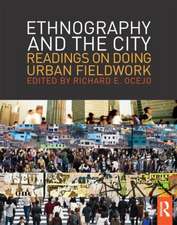International Handbook of Rural Demography: International Handbooks of Population, cartea 3
Editat de László J. Kulcsár, Katherine J. Curtisen Limba Engleză Paperback – 29 noi 2013
The growing complexity of rural society is in part a product of significant international variations in population trends, making this comparative and comprehensive study of rural demography all the more relevant. Collating the latest research on international rural demography, the handbook will be an invaluable aid to policy makers as they try to understand how demographic dynamics depend on the economic, social and environmental characteristics of rural areas. It will also aid researchers assessing the unique factors at play in the rural context and endeavoring to produce meaningful results that will advance policy and scholarship. Finally, the handbook is an ideal text for graduate students in a spread of disciplines from sociology to international development.
| Toate formatele și edițiile | Preț | Express |
|---|---|---|
| Paperback (1) | 1059.98 lei 38-45 zile | |
| SPRINGER NETHERLANDS – 29 noi 2013 | 1059.98 lei 38-45 zile | |
| Hardback (1) | 1071.83 lei 38-45 zile | |
| SPRINGER NETHERLANDS – 20 oct 2011 | 1071.83 lei 38-45 zile |
Preț: 1059.98 lei
Preț vechi: 1394.70 lei
-24% Nou
Puncte Express: 1590
Preț estimativ în valută:
202.82€ • 211.76$ • 167.86£
202.82€ • 211.76$ • 167.86£
Carte tipărită la comandă
Livrare economică 31 martie-07 aprilie
Preluare comenzi: 021 569.72.76
Specificații
ISBN-13: 9789400738317
ISBN-10: 9400738315
Pagini: 420
Ilustrații: XIV, 406 p.
Dimensiuni: 193 x 260 x 22 mm
Ediția:2012
Editura: SPRINGER NETHERLANDS
Colecția Springer
Seria International Handbooks of Population
Locul publicării:Dordrecht, Netherlands
ISBN-10: 9400738315
Pagini: 420
Ilustrații: XIV, 406 p.
Dimensiuni: 193 x 260 x 22 mm
Ediția:2012
Editura: SPRINGER NETHERLANDS
Colecția Springer
Seria International Handbooks of Population
Locul publicării:Dordrecht, Netherlands
Public țintă
ResearchCuprins
1: Why does rural demography still matter? : László J. Kulcsár.- 2: Challenges in the analysis of rural populations in the United States: Steve. H. Murdock, Michael Cline, Mary Zey.- 3: Rural natural increase in the new century: America’s third demographic transition: Kenneth M. Johnson, Daniel T. Lichter.- 4: Migration and rural population change: Comparative views in more developed nations: David Brown.- 5: World Urbanization: Destiny and reconceptualization: Avery M. Guest.- 6: Rural aging in international context: E. Helen Berry.- 7: Europe’s rural demography: Anthony Champion.- 8: The demography of rural Latin America: The case of Chile: Leif Jensen, David Ader.- 9: Rural demography in Asia and the Pacific Rim: Gavin Jones, Premchand Dommaraju.- 10: Demographic change and rural-urban inequality in Sub-Saharan Africa: Theory and trends: Parfait M Eloundou-Enyegue, Sarah C. Giroux.- 11: Demographic structure and process in rural China: Dudley L. Poston, JR., Mary Ann Davis, Danielle Xiaodan Deng.- 12: Rural population trends in Mexico: demographic and labor changes: Landy Sabches, Edith Pachecco.- 13: Rural demography in India: T.V. Sekher.- 14: The aboriginal people of Canada: a rural perspective: Gustave Goldmann.- 15: Rural race and ethnicity: Rogelio Sáenz.- 16: Family matters: gender, work arrangements, and the rural myth: Leann M. Tiggs, Hae Yeon Choo.- 17: Rural families in transition: Kristin E. Smith, Marybeth J. Mattingly.- 18: Rural health disparities: P. Johnelle Sparks.- 19: Perspectives on U.S. rural labor markets in the first decade of the twenty-first century: Alexander C. Vias.- 20: Race and place: Determinants of Poverty in the Texas borderland and the lower Mississippi Delte: Joachim Singelmann, Tim Slack, Kayla Fontenot.- 21: Rural jobs: Making a living in the countryside: Gary Paul green.- 22: The spatial heterogeneity and geographic extent of population deconcentration: Measurement and policyimplications: Joanna P. Ganning, Benjamin D. McCall.- 23: Integrating ecology and demography to understand the interrelationship between environmental issues and rural populations: Christopher A. Lepczyk, Marc Linderman, Roger B. Hammer.- 24: Boom or bust? Population dynamics in natural resource dependent counties: Richelle Winkler, Cheng Cheng, Shaun Golding.- 25: Neoliberal democratization and public health inequalities in Sub-Saharan Africa: A proposed conceptual and empirical design: Moshi Optat Herman.- 26: Divers ruralities in the 21st Century: from effacement to (re)invention: Keith Halfacree.
Recenzii
What is the meaning of “rural” in the highly interconnected global economies of the 21st Century? This masterful book addresses this question and several others by bringing together, in a single edited collection, the most up-to-date research on global rural demographic issues and trends possible. The editors are to be congratulated, first, for structuring a thoughtful and comprehensive set of highly relevant themes and, second, for recruiting a first-rate team of rural experts to share their latest research and insights. The book will appeal both to the rural practitioner and the specialist researcher/teacher for years to come.
Paul R. Voss
University of North Carolina at Chapel Hill
This handbook is a major contribution to rural demography, at a time of growing interest and activity in this field. The breadth in terms of topics and subjects represents a broad view of rural demography, covering relevant scholarship in the US and across the globe. An important and comprehensive work, this handbook should have a major impact on the continuing strength and growth of this aspect of demography.
Glenn V. Fuguitt
University of Wisconsin-Madison
Paul R. Voss
University of North Carolina at Chapel Hill
This handbook is a major contribution to rural demography, at a time of growing interest and activity in this field. The breadth in terms of topics and subjects represents a broad view of rural demography, covering relevant scholarship in the US and across the globe. An important and comprehensive work, this handbook should have a major impact on the continuing strength and growth of this aspect of demography.
Glenn V. Fuguitt
University of Wisconsin-Madison
Textul de pe ultima copertă
This is the third in an essential series of Springer handbooks that explore key aspects of the nexus between demography and social science. With an inclusive international perspective, and founded on the principles of social demography, this handbook shows how the rural population, which recently dropped below 50 per cent of the world total, remains a vital segment of society living in proximity to much-needed developmental and amenity resources. The rich diversity of rural areas shapes the capacity of resident communities to address far-reaching social, environmental and economic challenges. Some will survive, become sustainable and even thrive, while others will suffer rapid depopulation. This handbook demonstrates how these future development trajectories will vary according to local characteristics including, but not limited to, population composition.
The growing complexity of rural society is in part a product of significant international variations in population trends, making this comparative and comprehensive study of rural demography all the more relevant. Collating the latest research on international rural demography, the handbook will be an invaluable aid to policy makers as they try to understand how demographic dynamics depend on the economic, social and environmental characteristics of rural areas. It will also aid researchers assessing the unique factors at play in the rural context and endeavoring to produce meaningful results that will advance policy and scholarship. Finally, the handbook is an ideal text for graduate students in a spread of disciplines from sociology to international development.
The growing complexity of rural society is in part a product of significant international variations in population trends, making this comparative and comprehensive study of rural demography all the more relevant. Collating the latest research on international rural demography, the handbook will be an invaluable aid to policy makers as they try to understand how demographic dynamics depend on the economic, social and environmental characteristics of rural areas. It will also aid researchers assessing the unique factors at play in the rural context and endeavoring to produce meaningful results that will advance policy and scholarship. Finally, the handbook is an ideal text for graduate students in a spread of disciplines from sociology to international development.
Caracteristici
Addresses the current state of rural demography from both empirical and theoretical perspectives Explores the links between rural demography and social change in a range of contexts Traces links between the conceptualization and measurement of ‘rurality’ Exhaustive international focus























